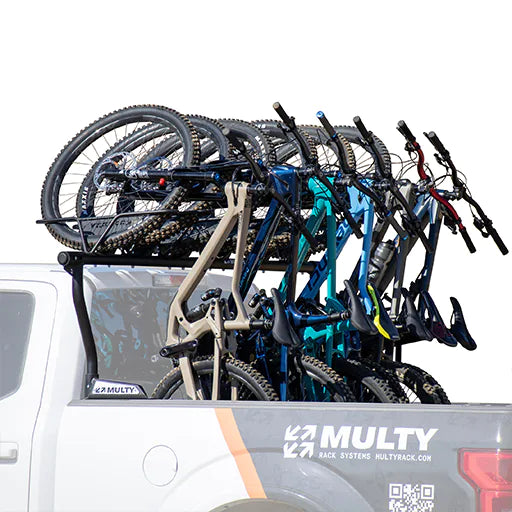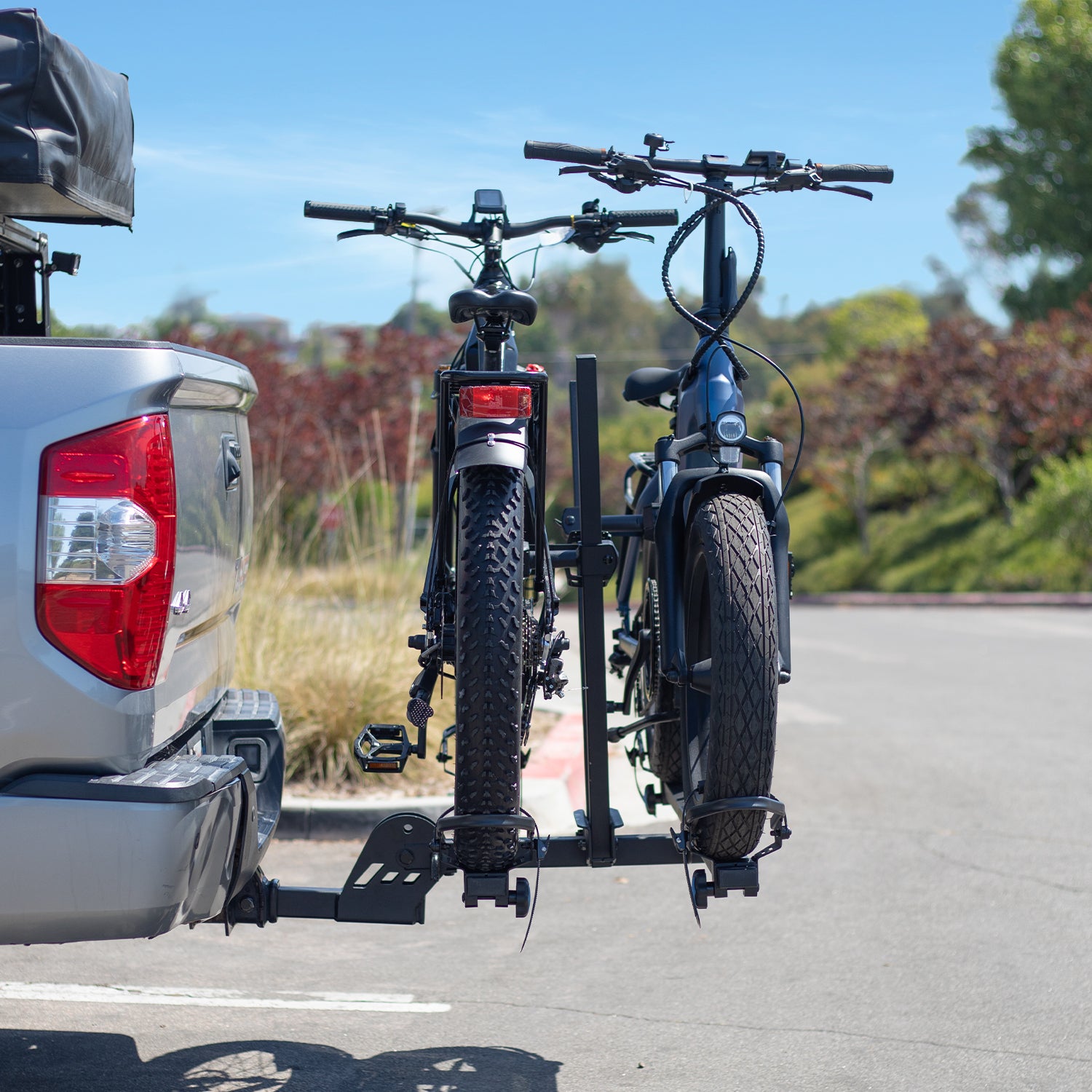How to Choose the Best Bike Rack for Your Car
Wiki Article
Explore the Different Kinds of Bike Shelf and Their Practical Applications for Cycling Enthusiasts
The selection of bike Racks available today deals with the diverse needs of cycling lovers. From freestanding to wall-mounted choices, each style uses special benefits for storage space and transportation. Mobile Racks also give adaptability for those on the relocation. Choosing the optimal type requires careful factor to consider of details demands. Recognizing these variables can make a substantial distinction in both convenience and safety and security for cyclists. What are the crucial factors to consider when selecting a bike shelf?Recognizing Bike Rack Types
Various sorts of bike Racks deal with the varied demands of bikers. Amongst one of the most typical are freestanding shelfs, commonly discovered in urban areas, which enable numerous bikes to be safeguarded in a small space. Wall-mounted Racks offer those with minimal floor space, providing a reliable solution for home storage space. In addition, portable bike shelfs, created for convenience of transportation, charm to bicyclists that often travel.
Hitch-Mounted Bike Racks
Hitch-mounted bike Racks offer a useful solution for transferring bikes, yet comprehending their setup process is vital for efficient use. Customers have to also consider the weight capacity of these Racks to guarantee safety and stability while traveling. Furthermore, compatibility with different lorry kinds plays a substantial function in determining the ideal rack for specific demands.Installment Process Review
When picking a hitch-mounted bike shelf, recognizing the installation process is vital for assuring safety and benefit. The user should verify compatibility between the shelf and the car's hitch receiver. Many Racks are developed for either 2-inch or 1.25-inch receivers. After choosing the appropriate rack, the installation begins with protecting the rack right into the hitch receiver and tightening the hitch pin or bolt to avoid activity. Appropriate positioning is crucial to ascertain the shelf does not obstruct tail lights or license plates. Once mounted, it is recommended to look for security by applying mild pressure to the rack. Adhering to the supplier's guidelines will certainly guarantee a successful installation, advertising a secure cycling experience on the road.Weight Capacity Considerations

Compatibility With Automobile Types
Selecting the ideal bike rack involves confirming compatibility with numerous automobile kinds. Hitch-mounted bike Racks are made to connect to the back hitch receiver of an automobile, making them ideal for a large range of vehicles, automobiles, and suvs. It is crucial to check the hitch course and weight ability to confirm an appropriate fit. A lot of hitch-mounted Racks are suitable with 1.25-inch and 2-inch receivers, accommodating automobiles geared up with appropriate lugging abilities. Additionally, customers ought to consider their automobile's height and layout, as some Racks might block rear accessibility or require extra clearance. Ultimately, understanding car specs validates that cycling lovers can safely deliver their bikes without endangering safety or capability.Trunk-Mounted Bike Racks
Trunk-mounted bike Racks use a practical option for bicyclists looking for an effective means to transfer their bikes. Comprehending the installment process is crucial for perfect usage, as improper arrangement can result in safety worries. Furthermore, considering the weight capability of these Racks guarantees that they can firmly hold the bikes without threat of damage or failure during transportation.Installation Refine Review
Many biking fanatics value the benefit of trunk-mounted bike Racks for their convenience of use and versatility. The installation procedure typically starts with acquainting and unloading the shelf oneself with its parts. Most Racks feature flexible bands and hooks designed to secure them to the lorry's trunk or hatch. Individuals must confirm the shelf is positioned properly, aligning it with the automobile's contours for security. Following the maker's directions, the bands are then tightened safely, ensuring a snug fit. It's vital to inspect that the rack does not obstruct the lorry's lights or permit plate. Validating that all links are secure before filling bikes is important for secure transport. Correct setup enhances both security and effectiveness throughout biking trips.Weight Ability Considerations
When taking into consideration a bike shelf for delivering bikes, weight ability is a crucial factor that can not be forgotten. Trunk-mounted bike Racks typically have weight limits that differ relying on the design and layout. It is essential for customers to examine these specs to ensure they do not exceed the recommended weight, as doing so can endanger both safety and car integrity. The majority of trunk-mounted Racks can support 1 or 2 bikes, with a mixed weight capability varying from 70 to 120 pounds. Cyclists ought to likewise think about the weight of their bikes, particularly if they possess much heavier designs like electrical bikes. Appropriately matching the rack's weight capability with the bikes' weights ensures a safe and safe transportation experience.Roof-Mounted Bike Racks
Roof-mounted bike Racks offer a streamlined remedy for transporting bikes, giving bicyclists with the advantage of making the most of cargo space. These Racks are designed to hold bikes securely atop the car, enabling for very easy accessibility to the back of the car and preventing blockages to the certificate plate or tail lights. They are optimal for individuals that frequently travel with their bikes, as they can fit numerous bike styles and sizes.Installation commonly involves connecting the rack to the automobile's bars, guaranteeing a secure and safe fit. Roof-mounted Racks are lightweight and frequently aerodynamic, which can lead to enhanced fuel efficiency contrasted to other types of racks. Nevertheless, customers ought to consider the elevation of their vehicle when packing and discharging bikes, as well as potential obstacles when going into garages or low-clearance locations. On the whole, roof-mounted bike Racks provide a versatile and efficient option for enthusiastic cyclists on the move
Wall-Mounted Bike Racks
Wall-mounted bike Racks give an efficient solution for bicyclists looking for to make best use of limited space while firmly storing their bikes. These Racks are perfect for city residents or those with tiny garages, as they raise bikes off the ground and utilize upright space. Made from tough products, wall-mounted options can accommodate different bike types, consisting of hybrid, roadway, and hill bikes.Setup is uncomplicated, making it possible for individuals to mount them in garages, basements, and even outside rooms. Many layouts permit one or several bikes, making them functional for individual or family usage. In addition, some wall-mounted Racks featured incorporated locks or security functions to hinder theft, improving assurance for bicyclists.
Portable Bike Racks
Portable bike Racks offer bikers a versatile and hassle-free option for moving their bikes. These Racks are made for very easy installation and removal, making them optimal for those that need to frequently switch over between locations or lorries. Usually lightweight and portable, portable bike Racks can be conveniently stored in a trunk or garage, minimizing the concern of Bike Rack long-term installments.There are numerous types of portable bike racks, consisting of hitch-mounted, trunk-mounted, and roof-mounted choices, each dealing with different automobile types and biker choices. Hitch-mounted Racks offer security and access, while trunk-mounted Racks are often more functional and economical. Roof-mounted Racks are wonderful for optimizing cargo area however might need some lifting.
Choosing the Right Bike Shelf for Your Demands
How can one identify the finest bike shelf to fit their certain biking demands? Identifying the ideal bike shelf includes evaluating a number of variables. First, one must consider the sort of car used for transportation, as Racks are created for different mounting systems, such as roof covering, trunk, or drawback. Next off, the number of bikes to be carried is important; some Racks suit only one, while others can hold several bikes effectively. In addition, determining the weight and frame style of the bikes is significant, as particular Racks are much better fit for much heavier or distinctively shaped bicycles. Ultimately, intended use needs to be taken into consideration; constant travelers might favor a more mobile choice, while periodic customers could focus on simplicity and convenience of installation. By thoroughly evaluating these considerations, individuals can pick a bike shelf that satisfies their requirements and enhances their cycling experience.
Often Asked Questions
Can Bike Racks Accommodate Different Bike Sizes and Styles?
Bike Racks differ in design, making it possible for lodging for various bike dimensions and designs. Some Racks include flexible components, while others are especially tailored for particular bikes, making sure protected storage space and simple ease of access no matter the bike's requirements.How Do I Appropriately Secure My Bike on a Shelf?
To effectively protect a bike on a rack, one ought to guarantee the framework and wheels are securely secured using bands or locks, looking for security and avoiding activity throughout transportation to avoid damages.Are Bike Racks Easy to Mount and Eliminate?
Bike Racks vary in installation complexity, yet many are designed for user-friendliness. Removable designs usually provide straightforward setup and removal, while permanent installments might need tools and more time, relying on the particular design.
What Materials Are Bike Racks Commonly Made From?
Bike Racks are normally made from materials such as aluminum, steel, and plastic. Hitch Bike Rack. Steel supplies sturdiness and stamina, while aluminum uses light-weight portability. Plastic alternatives are often made for convenience of use and costDo Bike Racks Affect Fuel Effectiveness When Driving?
When driving is significant, the concern of whether bike Racks affect fuel efficiency. Research studies show that bike Racks can increase wind resistant drag, possibly resulting in decreased fuel efficiency, especially at greater rates or with extra weight.After selecting the proper rack, the installation starts with securing the rack into the drawback receiver and tightening up the drawback pin or screw to protect against movement. Roof-mounted Racks are light-weight and commonly aerodynamic, which can lead to improved gas effectiveness compared to other types of racks. Hitch-mounted Racks supply stability and accessibility, while trunk-mounted Racks are typically much more versatile and budget-friendly. Next off, the number of bikes to be lugged is necessary; some Racks fit only one, while others can hold multiple bikes efficiently. Bike Racks differ in style, allowing accommodation for various bike dimensions and styles.
Report this wiki page